Dive Supervising
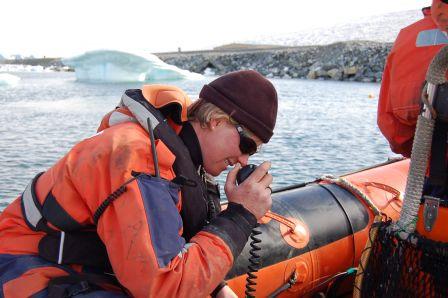
As part of the marine team we all train to be dive supervisors so we can all cox the boat, supervise the dive or indeed dive. This is a picture of me talking to the divers using the underwater comms system. As supervisor you do paperwork ashore and make sure all the safety equipment is onboard as well as the normal dive equipment. When on the water you tell the divers what depth and time they are allowed and work with the cox to determine the best place to put the divers in the water. We always enter the water at about 6 meters so that we are a silohette for the minimum amount of time and we then proceed to depth along the sea floor. Leopard seals find it hard to see you when you are not a silohette. You help the divers get kitted up and then carry out the checks (air, clips, weights, knives, guages and profile) then put on their full face masks for them and tell them when they can roll off the boat. You also talk to the person doing seal watch to make sure they have not seen leps or orcas. You note the time the divers leave the surface and stay in contact with them asking for air, telling them how much time till they need to be at safety, making sure they get to safety, keeping them clear or icebergs and telling them how far they are from surface items etc. You note when the diver gets to safety and also when they are leaving for the surface. The time is noted when they return to surface and you dekit them and help them out of the water. Also we put the animals they have collected into a bucket of water on the boat for transport back to the auarium. If a lep or orca turn up you instructed the divers on what action to take and also in the case of a diver accident take charge of getting them back to medical attention.
Culinary delights on a reflex stove
At Rothera we have two chefs so there is no food shoping to worry about etc. So when I went to Fossil Bluff it was fun to make food for the three of us there for the week. Most of the ingredients are dried and have to be rehydrated so you have to think in advance – dry corn, carrots, peas, beans, onions, olives, blueberries, egg, milk, black eyed beans, ming beans etc.
The ming beans can we soaked in water and put on the window sill and sprout about 4 days later giving a little greenery to the meals.

The bread I made was with wholemeal flour and dried yeast the problem was that straight out of the oven it smells so good you end up eating way more than you should.
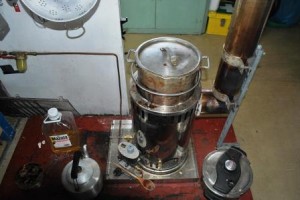
The oven is a pan with a trivet in the bottom to hold the thing you are cooking in the warm airspace with a lid on top on the reflex stove which is fueled with Avtur dregs from the plane fuel drums at the skiway.
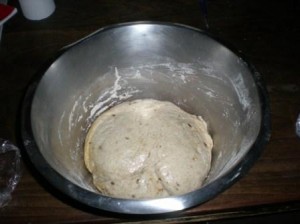
I also made some pizza dough for pizza one night.
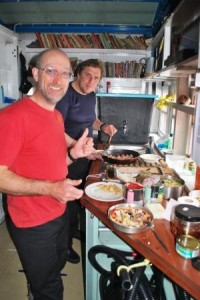
The guys piled on the ingredients..
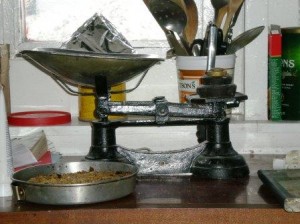
The scales are old fashioned…
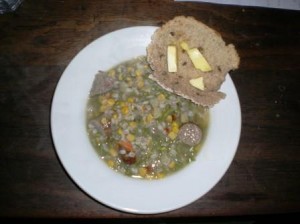
Soup and bread for lunch – tasty
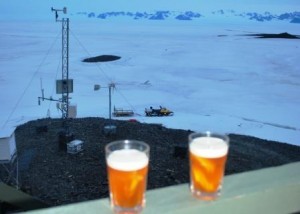
Jelly with whipped dried milk for dessert
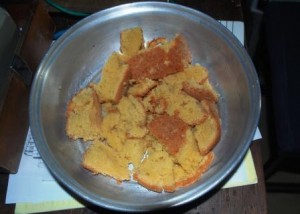
For the all day dessert trifle will use up many hours! First make the victoria sponge
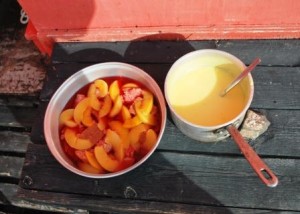
Then pour over jelly with peaches and let it set followed by making custard and pouring that on top and letting that set.
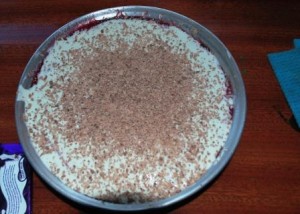
Then spend 3 hours whipping dried milk for a cream topping and grate chocolate on top.
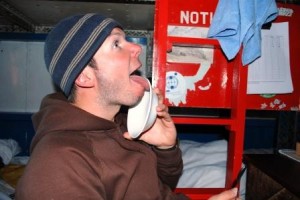
Eat and enjoy!
Scrub Out
Every Friday on base at 5pm all work stops and we have Scrub Out. Basically everyone on base has to do some cleaning whether it is cleaning windows, the FOD (foreign objects) plod (you pick up garbage and take it to the span), mopping out the boot rooms, moving food from feezers at the wharf etc. This is a picture of Clive and Amber washing down the bedroom doors in Admirals.
JJ and work
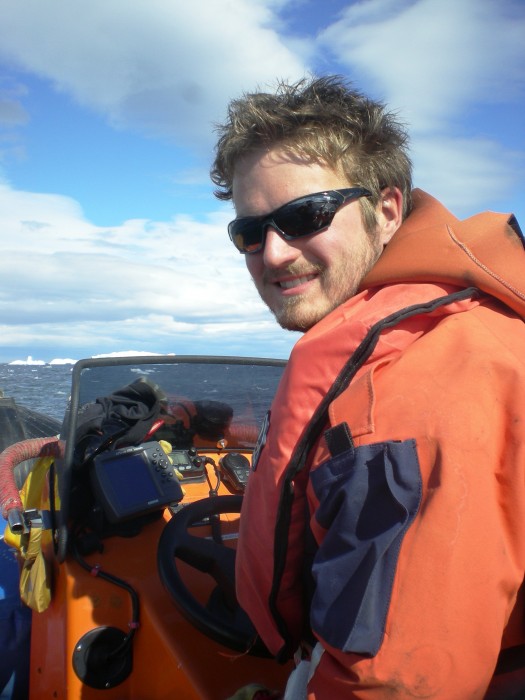
JJ (John James) is our young (24 I think) year old Diving Officer. This is him being the dive cox for a dive off east beach. JJ is passionate about diving. He has done a multitude of course at the DDRC in Plymouth and keeps us all safe in the water. This is his second season down here having summered last year but this time he is going to be wintering.
Fossils at the Bluff
In Belemnite Valley just a mile and half along Promenade scree from the hut there are a multitude of Belemnites in the frost shattered rocks.
The fossils have also shattered so it is very hard to find a whole one and be able to get it out of the rock without damage. This one took a long time and I removed the rock around it by hand.
Back from the field
I am back at Rothera after a brilliant week out in the field at Fossil Bluff at 71 20S 68 17W. The Bluff as it is called is 222 miles north of Sky Blu and 226 miles south of Rothera. Only 585 miles from the south pole. The hut is on Alexander Island which is 145 miles wide in the south, 40 miles wide in the north and 275 miles long. The King George VI Sound which divides the island from the peninsula is 300 miles long and between 15 and 40 miles long it is an ice shelf more than 150 feet deep fed by glaciers coming in from the sides. The 24 hour sunlight in the summer melts the surface creating streams and lakes. The ice front is receding down the sound.
There is evidence on Alexander Island of continental drift – igneous, metamorphism, sedimentation, earthquakes, faulting, glaciation, and fossils showing profusion of life in the past showing climate change. 50 miles north and south of the hut is an area of sedimentary rock that was in shallow water with a large variety of flora and fauna. There are fossils of belemnites, ammonites, brachiopods, bivalves, plant remains, mould, coprolites, fossil dung, coal surrounded by trees and a variety of other plants. Submarine molluscs, aucellina, inoceramus, fish teeth and annelids have all been found here. The north and west of Alexander turns to volcanic with pyroclastic flows, dykes and major uplifting. Across the sound on the peninsula the rocks are plutonic with granite, azurite and other minerals having been found. The rocks are frost shattered creating scree slopes.
There are many lateral and medial morraines showing the ice sheets and glaciers are retreating. The hut is built on a lateral morraine where the fossil bluff glacier (one mile long) meets the sound. The scree covered slopes rise 1200 feet behind. The hut is 200 feet above sea level and 40-50 feet above the level of the sound. From the porch to the north you can see the Eros Glacier and Sucession Cliffs. To the East is the Antarctic Peninsula and the Batterbee Mountains over 7500 feet and 45 km away.
The first people to stay in the hut wintered arriving on March 4th 1962 after a 10 day build team had put the hut together. The hut is 20 feet long and 14 feet wide framed of iron girders, insulated prefabricated walls and a very heavy door. The main living area is 13 by 14 feet.
Dive Comms
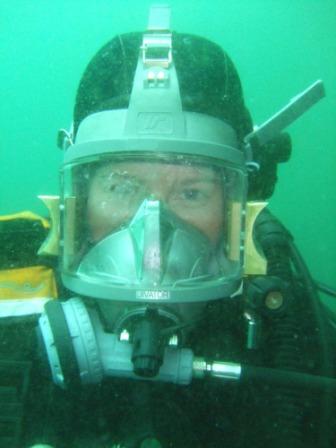
We wear full face masks when diving and inside the mask is a little microphone. To talk you push the button on the front of the mask (see picture) On the outside left strap of the mask is a speaker which sits against your ear but on the outside of the hood. Amazingly you can actually hear through the 5mm hood. The only problems occur if you don’t get the mask on tight enough and the bubbles escape out the sides running past the speaker.
This is the box that sits in the boat while the divers are underwater. There is a transponder that hangs over the side of the boat. There is not normally that much conversation it really depends on the divers.
When a diver first goes in the supervisor tests the comms
– diver terri, diver terri topside comms check
– the diver responds – topside strength (scale between 1 and 5)
– supervisor responds – diver terri strength (scale between 1 and 5). This process is repeated for the second diver.
During the dive the supervisor might ask the divers for an air check or tell them to expect seals or to move in a direction away from and iceberg. Normally 10 minutes before the end of the dive the supervisor will tell the divers the minutes remaining before they need to be at safety stop of 6m. The divers will tell the supervisor when they are at
safety stop and when they are coming to the surface.
A week or so ago when I was supervising a dive MVT called on channel 18 to ask if we had divers in as there was Orcas off the wharf. Luckily our divers were at their safety stop at the end of a sucessful dive so I called down. ”Both divers please return to the surface as soon as possible.’ which when a supervisor says something along those lines we know means there is a lep or orca around.
The comms is not just used for safety although that is the primary purpose. It is very helpful for the science side of things and allows me to learn more from the marine scientists as I can ask what certain things are making the dive more interesting.
Melt pond
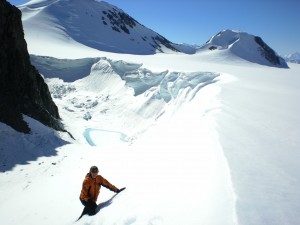
The picture is not of the pond at Fossil Bluff it is one of a very small glacier a few km from base.
There is a melt pond which is forming outside fossil bluff hut which sometimes gets so large that a boat is required to get from the ski way to the hut. Ponds of melted water can also develop under the ice. These ponds absorb the sun’s energy, rather than reflecting it as ice does, thereby having a significant influence on Earth’s radiation balance.
Adelie Penguins
Around Rothera we have a plethora of Adelie Penguins at the moment. At the beginning of the season they were a novelty however, now there are so many. They are one of the most common and well-known of all Antarctic penguin species. As one person put the other day it is hard to look at a penguin and not smile or laugh.
If you hang around long enough and make a call like theirs they will come right up to you and get within 2 feet or so of you. Apparently the meat is tough but tasty. However, I will not be eating on like my nephew suggested!
Weddell Seal
Weddell’s are the cutest seals at Rothera and stay around over the winter unlike the other seals which go out to sea. Their lifespan (20 years) is shorter as they use their teeth to ream out ice holes to breath through and their teeth wear out. Once a Weddell Seal’s teeth have worn down to a certain level, the seal is unable to eat and eventually starves to death.
Their pups are born in September. The Weddell Seal is known for its very deep dives, which may reach some 700 m (2,300 ft). It can also stay underwater for approximately 80 minutes.

